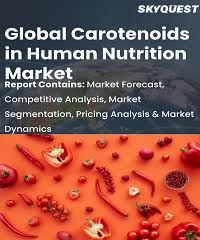Normal
0
false
false
false
EN-US
X-NONE
X-NONE
/* Style Definitions */
table.MsoNormalTable
{mso-style-name:”Table Normal”;
mso-tstyle-rowband-size:0;
mso-tstyle-colband-size:0;
mso-style-noshow:yes;
mso-style-priority:99;
mso-style-parent:””;
mso-padding-alt:0cm 5.4pt 0cm 5.4pt;
mso-para-margin-top:0cm;
mso-para-margin-right:0cm;
mso-para-margin-bottom:10.0pt;
mso-para-margin-left:0cm;
line-height:115%;
mso-pagination:widow-orphan;
font-size:11.0pt;
font-family:”Calibri”,sans-serif;
mso-ascii-font-family:Calibri;
mso-ascii-theme-font:minor-latin;
mso-hansi-font-family:Calibri;
mso-hansi-theme-font:minor-latin;
mso-bidi-font-family:”Times New Roman”;
mso-bidi-theme-font:minor-bidi;
mso-font-kerning:1.0pt;
mso-ligatures:standardcontextual;
mso-ansi-language:EN-US;
mso-fareast-language:EN-US;}
Global Carotenoids Market Insights
Global Carotenoids Market size was valued at USD 1.62 billion in 2021 and is poised to grow from USD 1.69 billion in 2022 to USD 2.37 billion by 2030, growing at a CAGR of 4.3% in the forecast period (2023-2030).
The global market for carotenoids is poised for significant growth, driven by expanding awareness regarding their potential benefits in addressing various health concerns such as macular degeneration, Parkinson’s disease, Alzheimer’s disease, and eye-related issues. Their role in protecting against heart disease and cancer, as well as their ability to slow down the aging process and exhibit potent antioxidant effects, further fuels their popularity.
Carotenoids have emerged as a preferred choice among both consumers and players in the food industry due to these compelling factors. Moreover, as consumer consciousness regarding synthetic additives in food deepens worldwide, there’s a surging demand for clean-label products. This has spurred an increased need for natural coloring agents in the food industry, with carotenoids, known for their red pigment, finding widespread use in the meat sector to impart color to products like salmon, trout, and various meat and fish items.
.
Global Carotenoids Market Segmental Analysis
The global carotenoids market is segmented into four segments i.e. by Product, source, application, and region. Based on source, the market is segmented as synthetic sources, and natural sources. Based on product, the market is segmented as, astaxanthin, zeaxanthin, crocetin, fucoxanthin, beta-carotenes, rhodoxanthin, and others. Based on application, the market is segmented as food, feed, pharmaceuticals and health care, and cosmetics. Based on Region the market is segmented as, North America, U.S., Canada, Mexico, Europe, Germany, UK, Italy, France, Spain, Rest of Europe, Asia-Pacific, Japan, China, India, South Korea, Australia, Rest of Asia-Pacific, LAMEA, Brazil, Saudi Arabia, Rest of LAMEA.
Analysis by Source
Synthetic sources held a commanding position within the industry, commanding a significant market share valued at USD 903.6 million. However, projections indicate a sluggish growth trajectory for this segment in the forecast period. This deceleration is primarily attributed to the burgeoning consumer inclination towards naturally sourced products.
The forecast for natural sources within the industry indicates a remarkable surge in both volume and revenue growth. These sources encompass an array of natural elements such as flowers, plant leaves, bird feathers, fruits, crustacean shells, and fish flesh. This anticipated growth trajectory is underpinned by an escalating consumer awareness regarding the myriad health benefits and advantages linked to natural products.
Analysis by Product
Beta-carotenes emerged as the dominant force within the industry, capturing a substantial 24% of the global volume share. Their multifaceted utility as a colorant, antioxidant, and significant source of vitamin A renders them indispensable across a spectrum of applications including food, feed, dietary supplements, cosmetics, and medicinal products. This versatility not only contributes to their prevalent use but also plays a pivotal role in stimulating the expansion of the carotenoids market size.
Astaxanthin is poised for substantial growth throughout the forecast period, driven by its expanding utilization across various domains. Its increasing application in animal feed ingredients, human antioxidant supplements, and as a coloring agent for shrimps, salmon, and trout positions it as a key player in the market’s growth trajectory. Additionally, its unique properties, including promoting rapid wound recovery and enhancing human stamina, further contribute to the industry’s development.


